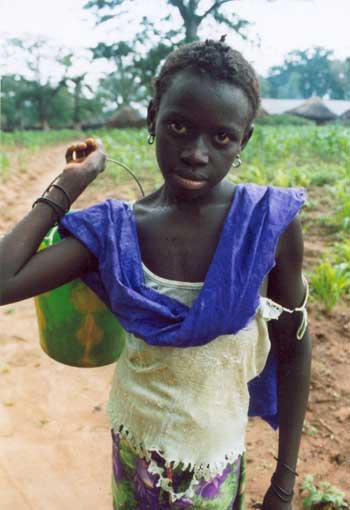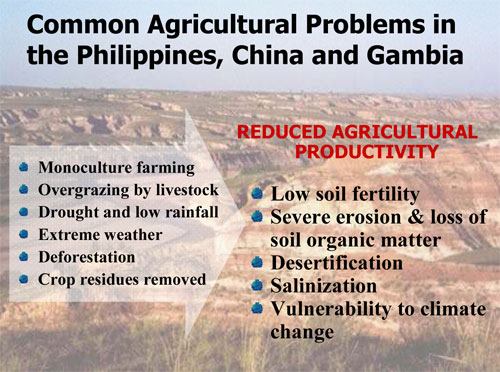Agro-Ecological Village Model

|
Many of these communities suffer from the following agricultural problems, which further degrades their environment and contributes to declining agricultural productivity:
 |
To address these challenges, REAP-Canada along with its Philippine partners, created the Agro-Ecological Village (AEV) Model in 1999, as a participatory approach to environmentally sustainable rural development that simultaneously addresses the social, ecological, and technological infrastructure development needs of communities. The AEV approach was a logical evolution for integrating and further building upon the existing participatory and sustainable agriculture efforts that had been underway for many years in rural development efforts in the Philippines. The AEV model fully emphasizes participatory planning, training, on-farm research and evaluation to create an ongoing capacity development and implementation of ecological agriculture and soil management systems.
Due to its ease of adoption and replication, the AEV is the basis for a model that meets the dual objectives of poverty alleviation and environmentally sound development, which can be easily adopted in developing communities around the world.
The AEV Model
An Agro-ecological Village can be described as a community that is largely self reliant through the creation of integrated and ecological food and energy production systems. Ecological resource management and sound community organizing forms the basis for sustainable AEV community development.| Click here to view a PowerPoint presentation on the AEV Model! |
 |
The AEV development strategy significantly improves agricultural production, well-being, and income and is an effective way of achieving results at low cost. The model innovatively incorporates participatory community input and planning into each step, ensuring activities are flexible and revolve around the interests and opportunities in each community. The adoption of this approach will improve a community's understanding of agro-ecological processes. Over time, this will:
- Increase the capacity of local communities to manage their resource base in a sustainable manner
- Provide farming families with food security, improved health and increased income and reduce their dependence on outside assistance
- Enable more dynamic participation of women in farming and marketing activities
- Reduce soil erosion and ensure the long-term capacity of the land for food production
- Improve surface and ground water quality and quantity
- Minimize the use of synthetic pesticides and fertilizers
- Reduce health risks to food producers and consumers
- Help protect and restore biodiversity
The general characteristics of an Agro-Ecological Village are outlined and
compared to conventional approaches in the following table:
| Activity | Conventional approach | Agro-Ecological system |
| Approach |
|
|
| Food supply and quality | Purchased foods (often processed and imported) and low diversity of diet, production focus on cash crops | Food security emphasized first through on-farm ecological production of principal food crops; quality diet supported by a diversity of seasonal production of fruits |
| Soil tillage | Annual crops emphasized and tillage performed with tractors powered by fossil fuels | Production systems include perennial crops and use of ground covers or crop residue mulches, tillage minimized through rotation and ecological soil fertility management |
| Soil fertility | Off-farm chemical N-P-K fertilizers | On-farm: Biological Nitrogen Fixation (BNF), compost, crop rotation, green manures and minimizing soil erosion |
| Weed and pest management | Chemical herbicides, insecticides and fungicides | Mechanical weeders, crop rotations, intercropping, biological-controls, to prevent weed growth compost is used for soil fertility management |
| Seeds | Purchased seeds sourced from outside the region. Hybrids commonly used which can’t be reproduced and selected locally. Some GMO seeds used. | Community seed banking of open pollinated seeds, new seeds assessed in trial farms, farmer driven participatory plant material assessment and breeding |
| Irrigation | Gasoline and diesel powered irrigation pumps | Use of ram, treadle and wind pumps for irrigation, use of low-water requiring drip irrigation systems, use of water collection cellars and check dams |
| Household cooking | Use of LPG, kerosene and charcoal fuels; 3 stone fire cooking with kerosene used as fire starter | Use of rice hull cookers, efficient wood stoves, biogas; solar stoves, all fuels farm-derived |
| Marketing | Cash crops; monoculture production; products sold through traders for distant markets | A diversity of year round local markets are created through diversified production and value added products created where appropriate |
| Finances | Heavy debt load at usury rates for high input requirements of monoculture cropping | Local Farmers Associations; efficient use of on-farm resources to minimize inputs |
| Training | Limited training of farmers; top down government trainers teaching high input farming methods. | Participatory Approaches emphasizing farmer to farmer training on ecological farming systems |
Learn more about:




